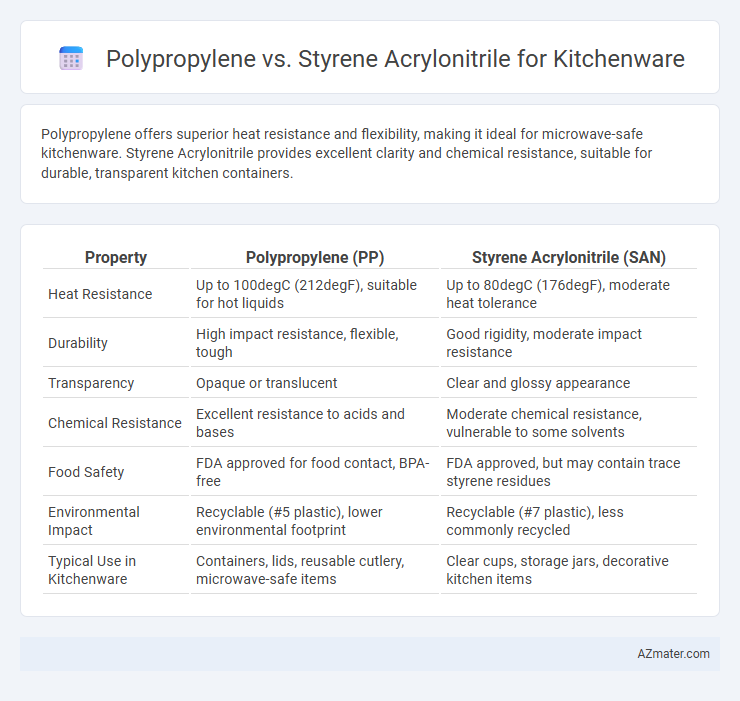Polypropylene offers superior heat resistance and flexibility, making it ideal for microwave-safe kitchenware. Styrene Acrylonitrile provides excellent clarity and chemical resistance, suitable for durable, transparent kitchen containers.
Table of Comparison
| Property | Polypropylene (PP) | Styrene Acrylonitrile (SAN) |
|---|---|---|
| Heat Resistance | Up to 100degC (212degF), suitable for hot liquids | Up to 80degC (176degF), moderate heat tolerance |
| Durability | High impact resistance, flexible, tough | Good rigidity, moderate impact resistance |
| Transparency | Opaque or translucent | Clear and glossy appearance |
| Chemical Resistance | Excellent resistance to acids and bases | Moderate chemical resistance, vulnerable to some solvents |
| Food Safety | FDA approved for food contact, BPA-free | FDA approved, but may contain trace styrene residues |
| Environmental Impact | Recyclable (#5 plastic), lower environmental footprint | Recyclable (#7 plastic), less commonly recycled |
| Typical Use in Kitchenware | Containers, lids, reusable cutlery, microwave-safe items | Clear cups, storage jars, decorative kitchen items |
Introduction to Kitchenware Materials
Polypropylene (PP) and Styrene Acrylonitrile (SAN) are widely used materials in kitchenware manufacturing due to their durability and safety. Polypropylene offers excellent heat resistance, chemical stability, and flexibility, making it ideal for microwave-safe containers and dishwasher-safe utensils. Styrene Acrylonitrile provides a glass-like clarity, superior stiffness, and resistance to impact, which suits transparent kitchen items such as cups and storage containers requiring aesthetic appeal and toughness.
Overview of Polypropylene (PP)
Polypropylene (PP) is a thermoplastic polymer widely used in kitchenware due to its excellent chemical resistance, durability, and heat tolerance up to 100degC (212degF). It is lightweight, non-toxic, and offers strong resistance to fatigue, making it ideal for reusable containers, cutting boards, and microwave-safe dishes. PP's compatibility with food contact regulations and its ability to withstand repeated washing without degrading contribute to its popularity in kitchen applications.
Overview of Styrene Acrylonitrile (SAN)
Styrene Acrylonitrile (SAN) is a copolymer made from styrene and acrylonitrile, known for its clarity, high strength, and chemical resistance, making it suitable for durable kitchenware. SAN resists heat and impact better than polypropylene, ensuring longevity in repeated use scenarios such as storage containers and microwave-safe dishes. Its smooth surface and resistance to stains and odors contribute to maintaining hygiene and preserving food quality.
Mechanical Properties: PP vs SAN
Polypropylene (PP) offers excellent impact resistance and flexibility, making it highly durable for kitchenware subjected to frequent use and drops. Styrene Acrylonitrile (SAN) provides superior stiffness and higher tensile strength, ensuring rigidity and resistance to deformation under heat. While PP excels in toughness, SAN stands out in structural stability, influencing material choice based on kitchenware function and durability requirements.
Heat Resistance Comparison
Polypropylene offers excellent heat resistance with a melting point around 160degC, making it suitable for microwave-safe kitchenware and hot food storage. Styrene Acrylonitrile (SAN) has a lower heat tolerance, typically up to 100degC, which limits its use for hot liquids or microwave applications. For kitchenware requiring sustained exposure to high temperatures, polypropylene provides superior thermal stability and durability.
Chemical Resistance in Kitchen Use
Polypropylene (PP) exhibits excellent chemical resistance to acids, bases, and alcohols commonly found in kitchen environments, making it highly suitable for food storage and preparation. Styrene Acrylonitrile (SAN), while offering good chemical resistance to oils and detergents, is more susceptible to stress cracking and degradation when exposed to strong alkalis or prolonged contact with acidic substances. Choosing polypropylene ensures better durability and longevity under typical kitchen chemical exposures, enhancing safety and usability in cookware and utensils.
Safety and Food Contact Compliance
Polypropylene (PP) is widely recognized for its excellent chemical resistance and high heat tolerance, making it a safer choice for kitchenware that comes into contact with food, while also complying with FDA and EU food contact regulations. Styrene Acrylonitrile (SAN) offers better rigidity and clarity but has lower heat resistance, restricting its use to applications with limited exposure to high temperatures and requiring careful compliance checks for food safety standards. Choosing between PP and SAN for kitchenware depends on balancing durability, heat resistance, and regulatory compliance to ensure safe food contact and consumer protection.
Durability and Longevity
Polypropylene offers exceptional durability for kitchenware due to its high impact resistance, chemical stability, and heat tolerance up to approximately 100degC, making it ideal for everyday use and dishwasher-safe items. Styrene acrylonitrile (SAN) provides moderate durability with superior clarity but lower heat resistance, typically up to 93degC, leading to a shorter lifespan under frequent thermal stress. Choosing polypropylene ensures better longevity and resistance to wear, cracking, and discoloration compared to SAN in kitchen applications.
Cost Efficiency for Manufacturers
Polypropylene offers cost efficiency for manufacturers due to its lower raw material and processing costs compared to Styrene Acrylonitrile (SAN), making it ideal for mass-produced kitchenware. SAN provides superior clarity and heat resistance but demands higher production expenses, resulting in increased manufacturing costs. Choosing polypropylene can significantly reduce overall expenses while maintaining durability and versatility in kitchenware applications.
Conclusion: Best Choice for Kitchenware
Polypropylene stands out as the best choice for kitchenware due to its superior heat resistance, chemical durability, and food safety compliance. Styrene Acrylonitrile, while offering good rigidity and clarity, lacks the same level of heat tolerance and may not withstand repeated dishwasher cycles as effectively. The combination of polypropylene's robustness and safety certifications makes it the optimal material for durable, everyday kitchen items.

Infographic: Polypropylene vs Styrene Acrylonitrile for Kitchenware
 azmater.com
azmater.com